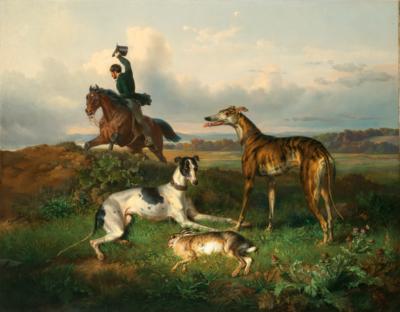Theodor Franz Zimmermann

(Nassereith 1808–1880 Vienna)
After a Successful Hunt, signed, dated T. F. Zimmermann 1851, oil on canvas, 87 x 112 cm, framed
Provenance:
Wiener Kunstauktionen, 10 June 1997, lot 52.
Following his artistic training in Königsberg and Berlin, the German-Austrian painter Theodor Franz Zimmermann concentrated on animal depictions. He illustrated parts of the zoological works of the famous animal researcher Alfred Brehm, amongst other things. Hunting scenes in particular were a popular, often repeated motif for Zimmermann.
The present lot offers a view of hare coursing. Traditionally, tall, slender sighthounds are used for this purpose. Due to their enormous speed, they hunt by sight and not by scent. In German-speaking countries, hare coursing is no longer pursued; it used to take place either on foot or - as shown here - on horseback. The hounds were only let loose after they had caught sight of their prey. In a hunt with two greyhounds, the “rescuer” was often responsible for preventing the former from eating the hare. Zimmermann captures this exact moment, while the rider in the background obviously wants to draw the attention of a hunting party not visible in the picture to the catch.
Esperta: Johanna Plank, MA
 Johanna Plank, MA
Johanna Plank, MA
+43-1-515 60-501
johanna.plank@dorotheum.at
08.11.2022 - 17:00
- Stima:
-
EUR 25.000,- a EUR 30.000,-
Theodor Franz Zimmermann
(Nassereith 1808–1880 Vienna)
After a Successful Hunt, signed, dated T. F. Zimmermann 1851, oil on canvas, 87 x 112 cm, framed
Provenance:
Wiener Kunstauktionen, 10 June 1997, lot 52.
Following his artistic training in Königsberg and Berlin, the German-Austrian painter Theodor Franz Zimmermann concentrated on animal depictions. He illustrated parts of the zoological works of the famous animal researcher Alfred Brehm, amongst other things. Hunting scenes in particular were a popular, often repeated motif for Zimmermann.
The present lot offers a view of hare coursing. Traditionally, tall, slender sighthounds are used for this purpose. Due to their enormous speed, they hunt by sight and not by scent. In German-speaking countries, hare coursing is no longer pursued; it used to take place either on foot or - as shown here - on horseback. The hounds were only let loose after they had caught sight of their prey. In a hunt with two greyhounds, the “rescuer” was often responsible for preventing the former from eating the hare. Zimmermann captures this exact moment, while the rider in the background obviously wants to draw the attention of a hunting party not visible in the picture to the catch.
Esperta: Johanna Plank, MA
 Johanna Plank, MA
Johanna Plank, MA
+43-1-515 60-501
johanna.plank@dorotheum.at
|
Hotline dell'acquirente
lun-ven: 10.00 - 17.00
kundendienst@dorotheum.at +43 1 515 60 200 |
| Asta: | Dipinti dell’Ottocento |
| Tipo d'asta: | Asta in sala con Live Bidding |
| Data: | 08.11.2022 - 17:00 |
| Luogo dell'asta: | Wien | Palais Dorotheum |
| Esposizione: | 22.10. - 08.11.2022 |
